




Employees who give or display signals must have the proper appliances. Appliances must be in good condition and ready to use.
To recognize and follow signals correctly, employees must:
To give clear signals during the day and at night, employees must:
A. During the Day
B. At Night
light, a minimum of eight torpedoes, and six red fusees. Flags may be made from cloth, metal, or other suitable material.
The following diagram illustrates the hand signals for a train or
engine to stop,
proceed, or back up. 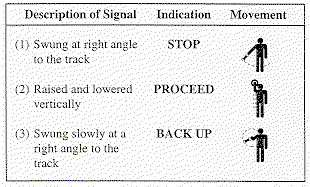 Employees may use other hand signals only if all crew members
understand the
signals. When employees are not giving hand signals, they must not make
any gestures or
movements that may resemble a hand signal.
Employees may use other hand signals only if all crew members
understand the
signals. When employees are not giving hand signals, they must not make
any gestures or
movements that may resemble a hand signal.
Employees who give signals must:
If a person disappears who is giving the signal to back or shove a train, engine, or car, or the light being used disappears, employees must:
Any object waved violently by any person on or near the track is a signal to stop.
Acknowledge any signal to stop a train unless it is a fixed signal. When flagged, the engineer must obtain a thorough explanation from the flagman before proceeding.
Employees may use radio and other means of voice communication to give information when using hand signals is not practical. Employees must make sure crew members:
When radio communication is used to make movements, crew members must respond to specific instructions given for each movement. In addition:
Movement must stop within half of the distance specified unless additional instructions are received.
Track bulletins, track warrants, or general orders may restrict or stop train movements because of track conditions, structures, men, or equipment working. Yellow flags will be used for temporary speed restrictions. Yellow-red flags will be used when a train may be required to stop.
A. Restriction Specified in Writing
Two Miles Ahead of Restricted Area. Yellow flags warn trains to restrict movement because of track conditions or structures. To make sure train movement is restricted at the right location, employees must display a yellow flag 2 miles before the restricted area
 Less than Two Miles Ahead of Restricted Area. When the
restricted area
is close to a terminal, junction, or another area, employees will display
the yellow flag
less than 2 miles before the restricted area. This information will also
be included in
the track bulletin, track warrant, or general order.
Less than Two Miles Ahead of Restricted Area. When the
restricted area
is close to a terminal, junction, or another area, employees will display
the yellow flag
less than 2 miles before the restricted area. This information will also
be included in
the track bulletin, track warrant, or general order.
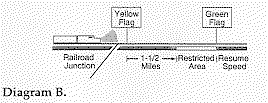 Once the Train Reaches the Restricted Area. The speed
specified by
track warrant, track bulletin, or general order must not be exceeded until
the rear of the
train clears the restricted area.
Once the Train Reaches the Restricted Area. The speed
specified by
track warrant, track bulletin, or general order must not be exceeded until
the rear of the
train clears the restricted area.
B. Restriction Is Not Specified in Writing
When a yellow flag is displayed and the restriction is not specified by a track bulletin, track warrant, or general order, once the train is 2 miles beyond the yellow flag, crew members must:
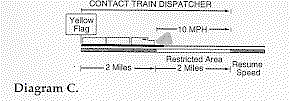
A. Restriction Specified in Writing
Two Miles Ahead of Restricted Area. Yellow-red flags warn a train to be prepared to stop because of men or equipment. To make sure the train is prepared to Stop at the right location, employees must display a yellow-red flag 2 miles before the restricted area.
 Less Than Two Miles Ahead of Restricted Area. When the
restricted area
is close to a terminal, junction, or another area, employees will display
the yellow-red
flag less than 2 miles before the restricted area. This information will
also be included
in the track bulletin, track warrant, or general order.
Less Than Two Miles Ahead of Restricted Area. When the
restricted area
is close to a terminal, junction, or another area, employees will display
the yellow-red
flag less than 2 miles before the restricted area. This information will
also be included
in the track bulletin, track warrant, or general order.
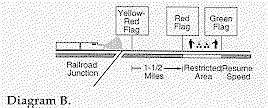 B. Restriction Is Not Specified in Writing
B. Restriction Is Not Specified in Writing
When a yellow-red flag is displayed and the restriction is not specified by a track bulletin, track warrant, or general order, crew members must be prepared to stop short of a red flag 2 miles beyond the yellow-red flag. If a red flag is displayed, proceed as outlined in Rule 5.4.7 (Display of Red Flag or Red Light). If no red flag is displayed:
On subdivisions where maximum speed does not exceed 40 MPH, and it is authorized by special instructions, yellow or yellow-red flags may be displayed without the use of track bulletins, track warrants, or flagmen. Yellow or yellow-red flags must be displayed 2 miles before the restricted area. Protection will begin at a point 2 miles beyond the yellow or yellow-red flag and continue for 2 more miles, as outlined in Rule 5.4.2 (Display of Yellow Flag) and Rule 5.4.3 (Display of Yellow-Red Flag).
Note: Crew members do not need to receive verification from the train dispatcher when this rule is in effect.
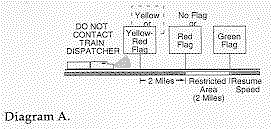
A green flag indicates the end of a restricted area. If a series of locations require reduced speeds or protection for men or equipment, the green flags could overlap yellow or yellow-red flags. When this is the case, employees must:
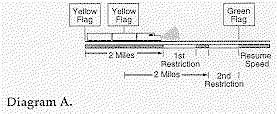
A. Yellow and Green Flags
Flags for temporary speed restrictions will only be placed for trains moving with the current of traffic.
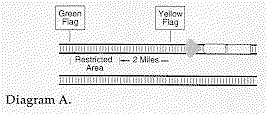 B. Yellow-Red and Green Flags
B. Yellow-Red and Green Flags
Flags protecting men or equipment must be placed in both directions on each track affected.
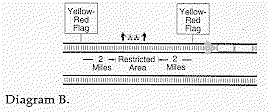
A red flag or red light is displayed where trains must stop. When approaching a red flag or red light, the train must stop short of the red flag or red light and not proceed unless the employee in charge gives verbal permission. If permission to proceed is received before the train stops, the train may pass the red flag or red light without stopping.
If track bulletin Form B is not in effect, permission must include speed and distance. This speed must not be exceeded until the rear of the train has passed the specified distance from the red flag or red light, unless otherwise instructed by the employee in charge.
Displayed Between Rails. When a red flag or red light is displayed between the rails of a track other than a main track or controlled siding, the train must stop and not proceed until the flag or light has been removed by an employee of the class that placed it.
Flags will be displayed only on the track affected. However, when yellow, yellow-red, or red flags or red lights are used for protection without a flagman, track bullefin, track warrant, or general order, these flags must be placed to protect all possible access to the restricted area.
Flags must be displayed to the right of the track as viewed from an approaching train, except red flags or red lights may be displayed between the rails as outlined in Rule 5.4.7 (Display of Red Flag or Red Light). Flags will be placed in this manner unless otherwise specified by track bulletin, track warrant, special instructions, or general order.
When flags are displayed beyond the first rail of an adjacent track, the flags will not apply to the track on which the train is moving.
Permanent speed restriction signs will be placed in advance of permanent speed restrictions. Numbers on the face of these signs indicate the highest speed permitted over the limits of the restriction.
Two Sets of Numbers
When two sets of numbers are shown, the greater number govems trains consisting entirely of passenger equipment. The lesser number governs all other trains.
Resume Speed Signs
A permanent resume speed sign or a speed sign showing a higher speed will be placed at the end of each restriction.
Crew members must not exceed the speed shown on each permanent speed restriction sign until the rear of the train:

If a train approaches an unattended fusee burning on or near its track, the train must stop before passing the fusee, if consistent with good train handling.
 A train moving at restricted speed must stop before passing
the fusee.
A train moving at restricted speed must stop before passing
the fusee.
 After the fusee bums out, or after 10 minutes if the fusee is
not visible,
the train must proceed at restricted speed until the head end is 1 mile
beyond the fusee.
After the fusee bums out, or after 10 minutes if the fusee is
not visible,
the train must proceed at restricted speed until the head end is 1 mile
beyond the fusee.
If the unattended burning fusee is beyond the first rail of an adjacent track, the fusee does not apply to the track on which the train is moving.
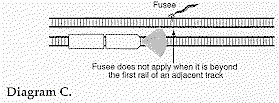 Do not place fusees where they may cause fires.
Do not place fusees where they may cause fires.
If one or more torpedoes explode, the train must slow to restricted speed immediately and remain at this speed until the head end is 2 miles beyond where the torpedoes exploded.
 When placing torpedoes, two must be placed not less than 150
feet apart on
each rail. They must not be placed near station buildings, crossings, or
on other than
main tracks or sidings.
When placing torpedoes, two must be placed not less than 150
feet apart on
each rail. They must not be placed near station buildings, crossings, or
on other than
main tracks or sidings.

Ring the engine bell under any of the following conditions:
When weather conditions impair visibility, sound the whistle frequently.
If the whistle fails, ring the bell continuously while moving.
When other employees are working in the immediate area, sound the required whistle signal before moving.
The radio may be used in place of whistle signals, except signals (1) and (1 1). See following chart.
The required whistle signals are illustrated by "o" for short sounds and "-" for longer sounds:
Sound Indication (1) Succession of short Use when an emergency exists, or persons sounds or livestock are on the track. When crews on other trains hear this signal, they must stop until it is safe to proceed. (2) - When stopped: air brakes are applied, pressure equalized. (3) - - Release brakes. Proceed. (4) o o Acknowledgment of any signal not otherwise provided for. (5) o o o When stopped: back up. Acknowledgment of hand signal to back up. (6) o o o o Request for signal to be given or repeated or not understood. (7) - o o o Flagman protect rear of train. (8) o o o - Flagman protect front of train. (9) - - - - Flagman may return from west or south. (10) - - - - - Flagman may return from east or north. (11) - - o - Approaching public crossings at grade with engine in front, start signal not less than 1/4 mile before reaching crossing, if distance permits. If distance does not permit, start signal soon enough before the crossing to provide wan-dng. Prolong or repeat signal until engine occupies the crossing. Use this signal to warn employees when view is restricted. (12) 0 - Inspect brake system for leaks or sticking brakes.
Turn the headlight on bright to the front of every train, except when the light must be dimmed as outlined in Rule 5.9.1 (Dimming Headlight) or turned off as outlined in Rule 5.9.2 (Headlight Off).
Except when the engine is approaching and passing over a public crossing at grade, dim the headlight during any of the following conditions:
1. At stations and yards where switching is being done.
 2. When the engine is stopped close behind another train.
2. When the engine is stopped close behind another train.
 3. In non-signaled territory, when the engine is stopped on
the main track
waiting for an approaching train.
3. In non-signaled territory, when the engine is stopped on
the main track
waiting for an approaching train.
 4. When approaching and passing the head end and rear end of
a train on the
adjacent track.
4. When approaching and passing the head end and rear end of
a train on the
adjacent track.
 5. At other times to permit passing of hand signals or when
the safety of
employees requires.
5. At other times to permit passing of hand signals or when
the safety of
employees requires.

Turn the headlight off under either of the following conditions:
1. When the train is stopped in the clear of the main track to meet a train. However, an extinguished headlight does not indicate to an opposing train that a train is clear of the main track.
 2. Within block system limits, when the train is stopped on
the main track to
meet a train approaching on the same track.
2. Within block system limits, when the train is stopped on
the main track to
meet a train approaching on the same track.
 If the headlight on the train fails, ditch lights must be on,
when so
equipped. Headlight failure must be reported to the train dispatcher.
If the headlight on the train fails, ditch lights must be on,
when so
equipped. Headlight failure must be reported to the train dispatcher.
At night, if headlight and ditch lights fail to operate and no other unit can be used as the lead unit, continue movement with a white light displayed on the lead unit. Stop the train before each public crossing, so a crew member on the ground can provide warning until the crossing is occupied, unless:
When engines are moving, crew members must tum on the headlight to the front and rear, but may dim or extinguish it on the end coupled to cars.
Display ditch lights, if available, to the front of the train when the headlight is on bright.
If the leading engine is equipped with an oscillating white headlight, tum the light on when the engine is moving. However, turn the light off when meeting trains, passing trains, or during switching operations, unless movement involves public crossings at grade.
If the leading engine is equipped with an oscillating or flashing red light, tum the light on under any of the following conditions:
The red light signals an approaching train on the same or adjacent track to stop at once and to proceed only after the track is safe for train passage. Extinguish red flashing lights when they are no longer needed.
Displaying these lights does not modify the requirements of Rule 6.19 (Flag Protection) or Rule 6.23 (Emergency Stop or Severe Slack Action).
If engine is equipped with an amber or white cab roof light that revolves or flashes, display the light on the occupied controlling unit.
A marker of the prescribed type must be displayed on the trailing end of the rear car to indicate the rear of the train.
Display a highly visible marker at the rear of every train as follows:
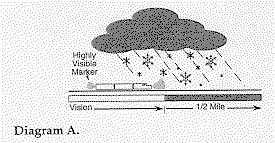 A marker equipped with a functioning photo-electric cell will
automatically
illuminate at the appropriate time.
A marker equipped with a functioning photo-electric cell will
automatically
illuminate at the appropriate time.
When an engine is operating without cars or is at the rear of the train, the trailing headlight illuminated on dim may be used as a marker. Inspection of Marker
When a highly visible marker is required, a qualified employee must inspect it at the initial terminal and at each crew change point. To determine if the marker is functioning properly, the employee will inspect it by observation or by telemetry display in the cab of the engine. The engineer must be informed of the results of the inspection.
Display a reflector, red flag, or light fixture at the rear of the train as the marker when any of the following conditions exists:
Trains will be identified by engine number, adding the direction when required. When an engine of another company is used, the initials of the company will precede the engine number. When an engine consists of more than one unit or when two or more engines are coupled, the number of one unit only will be illuminated as the identifying number. When practical, use the number of the leading unit.
This rule outlines the requirements for protecting occupied outfit cars. As used in this rule, the following definitions apply:
Outfit Car. Any on-track vehicle, including outfit, camp, or bunk car or modular home mounted on a flat car to house railroad employees. Such equipment is not considered an outfit car when placed in a wreck train.
Effective Locking Device. When used in relation to a manually operated switch or a derail, a lock that can be locked or unlocked only by the craft or group of workmen applying the lock.
Rolling Equipment. Engines, cars, and one or more engines coupled to one or more cars.
Switch Providing Direct Access. A switch that if used by rolling equipment could permit the rolling equipment to couple to the equipment being protected.
Warning Signal. A white sign that reads, "OCCUPIED CAMP CAR" in black lettering. At night, an illuminated white light must also be used.
When occupied outfit cars are placed on a track, the employee in charge of the outfit car occupants (or a designated representative) must provide or request protection using one of the following methods:
A. On a Main Track
One of these two methods or a combination of these methods must be provided:
1. Each manually operated switch that provides direct access to that portion of the main track where occupied outfit cars are located must be lined against movement to that track, secured with an effective locking device, and spiked or clamped. Waming signals must be displayed at or near each switch.
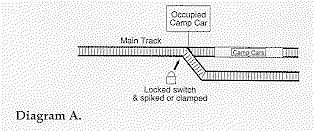 2 If remote control switches provide direct access to the
main track where
occupied outfit cars are located, the control operator will line the
switch against
movement to that track and apply blocking devices to the control machine
to prevent
movement onto that track. The control operator must complete the above
tasks before
informing the employee requesting protection that protection is provided.
2 If remote control switches provide direct access to the
main track where
occupied outfit cars are located, the control operator will line the
switch against
movement to that track and apply blocking devices to the control machine
to prevent
movement onto that track. The control operator must complete the above
tasks before
informing the employee requesting protection that protection is provided.
Blocking devices must not be removed until the employee in charge of the outfit car occupants (or a designated representative) informs the control operator that protection is no longer required. a. Warning signals must be displayed at or near each remote control switch.
b. In addition, a derail capable of restricting access to the portion of main track where occupied outfit cars are located must be placed at least 150 feet from the end of the occupied outfit cars. The derail must be locked in derailing position with an effective locking device. Warning signals must be displayed at each derail.
c. The control operator must maintain for 15 days a written record of each notification. The record must contain the following information:
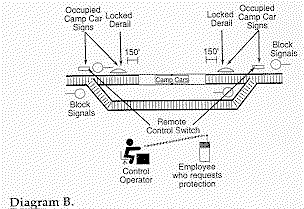 B. On Other than a Main Track
B. On Other than a Main Track
One of these three methods of protection or a combination of these methods must be provided:
1. Each manually operated switch that provides direct access to the track where occupied outfit cars are located must be lined against movement to that track and secured with an effective locking device. Warning signals must be displayed at or near each switch.
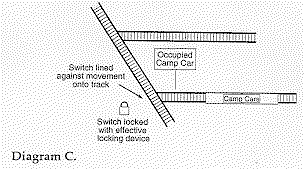 2. If remote control switches provide direct access to the
track where
occupied outfit cars are located, the control operator will line the
switch against
movement to that track and apply blocking devices to the control machine
to prevent
movement onto that track. The control operator must complete the above
tasks before
informing the employee requesting protection that protection is provided.
2. If remote control switches provide direct access to the
track where
occupied outfit cars are located, the control operator will line the
switch against
movement to that track and apply blocking devices to the control machine
to prevent
movement onto that track. The control operator must complete the above
tasks before
informing the employee requesting protection that protection is provided.
Blocking devices must not be removed until the employee in charge of the outfit car occupants (or a designated representative) informs the control operator that protection is no longer required. a. Warning signals must be displayed at or near each remote control switch.
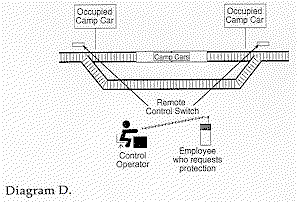 b. The control operator must maintain for 15 days a written
record of each
notification. The record must contain the following information:
b. The control operator must maintain for 15 days a written
record of each
notification. The record must contain the following information:
3. A derail capable of restricting access to that portion of the track where occupied outfit cars are located will fulfill the requirements of protection when the derail is:
Warning signals must be displayed at each derail.
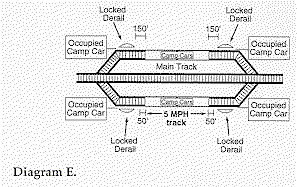 C. Warning Signals When a warning signal is displayed
to protect
occupied outfit cars:
C. Warning Signals When a warning signal is displayed
to protect
occupied outfit cars:
This rule outlines the requirements for protecting railroad workmen who are inspecting, testing, repairing, and servicing rolling equipment. In particular, because these tasks require the workmen to work on, under, or between rolling equipment, workmen are exposed to potential injury from moving equipment.
As used in this rule, the following definitions apply:
Workmen. Railroad employees assigned to inspect, test, repair, or service railroad rolling equipment or components, including brake systems. Train and yard crews are excluded, except when they perform the above work on rolling equipment not part of the train or yard movement they are handling or will handle.
Group of Workmen.
Two or more workmen of the same or different crafts who work as a unit under a common authority and communicate with each other while working.Rolling Equipment. Engines, cars, and one or more engines coupled to one or more cars.
Blue Signal. During the day, a clearly distinguishable blue flag or light, and at night, a blue light. The blue light may be steady or flashing.
The blue signal does not need to be lighted when it is attached to the operating controls of an engine and the inside of the engine cab area is lighted enough to make the blue signal clearly distinguishable.
Effective Locking Device. When used in relation to a manually operated switch or a derail, a lock that can be locked or unlocked only by the craft or group of workmen applying the lock.
Car Shop Repair Area. One or more tracks within an area where rolling equipment testing, servicing, repairing, inspecting, or rebuilding is controlled exclusively by mechanical department personnel.
Engine Servicing Area. One or more tracks within an area where engine testing, servicing, repairing, inspecting, or rebuilding is controlled exclusively by mechanical department personnel.
Switch Providing Direct Access. A switch that if used by rolling equipment could permit the rolling equipment to couple to the equipment being protected.
A. What a Blue Signal Signifies
A blue signal signifies that workmen are on, under, or between rolling equipment and requires that:
Blue signals or remote control blue signals must be displayed for each craft or group of workmen who will work on, under, or between rolling equipment.
Protection Removed. Blue signals may be removed only by the craft or group who placed them. Remote control display may be discontinued when directed by the craft or group that requested the protection. When blue signal protection has been removed from one entrance of a double-ended track or from either end of rolling equipment on a main track, that track is no longer under blue signal protection.
B. How to Provide Protection
When workmen are on, under, or between rolling equipment and exposed to potential injury, protection must be provided as follows:
On a Main Track. A blue signal must be displayed at each end of the rolling equipment.
On Other than a Main Track. One of these three methods of protection or a combination of these methods must be provided:
Each manually operated switch that provides direct access must be lined against movement onto the track and secured by an effective locking device. A blue signal must be placed at or near each such switch. In addition, any facing point crossover switch must be lined against movement and secured by an effective locking device.
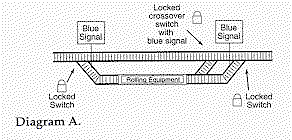 2. A derail capable of restricting access to the track where
work will occur
must be locked in derailing position with an effective locking device and:
2. A derail capable of restricting access to the track where
work will occur
must be locked in derailing position with an effective locking device and:
A blue signal must be displayed at each derail.
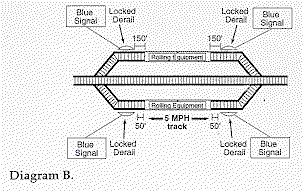 3. Where remote control switches provide direct access, the
employee in
charge of the workmen must tell the switch operator what work will be
done. The switch
operator must then:
3. Where remote control switches provide direct access, the
employee in
charge of the workmen must tell the switch operator what work will be
done. The switch
operator must then:
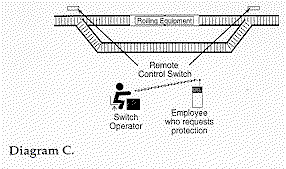 C. Blue Signal Readily Visible to Engineer
C. Blue Signal Readily Visible to Engineer
In addition to providing protection as required in 'On a Main Track" and "On Other than a Main Track," when workmen are on, under, or between an engine or rolling equipment coupled to an engine:
 D. Protection for Workmen Inspecting Markers
D. Protection for Workmen Inspecting Markers
Blue signal protection must be provided for workmen when they are:
E. Protection for Emergency Repair Work
If a blue signal is not available for employees performing emergency repairs on, under, or between an engine or rolling equipment coupled to an engine, the employee controlling the engine must be notified and appropriate measures taken to provide protection for the employees.
F. Movement in Engine Servicing Area An engine must not enter a designated engine servicing area until the blue signal protection is removed from the entrance. The engine must stop short of coupling to another engine.
An engine must not leave a designated engine servicing area unless the blue signal is removed from the engine and the track in the direction of movement.
Blue signal protection removed to let engines enter or leave the engine servicing area must be restored immediately after the engine enters or clears the area.
An engine protected by blue signals may be moved on a designated engine servicing area track when:
G. Movement in Car Shop Repair Area
When rolling equipment on car shop repair tracks is protected by blue signals, a car mover may reposition the equipment if:When a sign reading:
STOP - TANK CAR CONNECTED
STOP - MEN WORKING
EMPLOYEES WORKING
SERVICE CONNECTIONS
or a similar warning is displayed on a track or car, the car must not be coupled to or moved. Other equipment must not be placed on the same track in a manner that would block or reduce the view of the sign.
If a signal is improperly displayed, or a signal, flag, or sign is absent from the place it is usually shown, regard the signal as showing the most restrictive indication it can give. However, if a semaphore arm is visible, it will govern.
Promptly report improperly displayed signals or absent fixed signals, flags, or signs to the train dispatcher.
Crew members in the engine control compartment must be alert for signals. As soon as signals become visible or audible, crew members must communicate clearly to each other the name or aspect of signals affecting their train. They must continue to observe signals and announce any change of aspect until the train passes the signal.
If the signal is not complied with promptly, other crew members must remind the engineer and/or conductor of the rule requirement. If the crew members receive no response or if the engineer is unable to respond, they must immediately take action to ensure safety, using the emergency brake valve to stop the train, if necessary.
Next Chapter - Movement of Trains and Engines